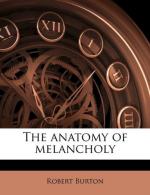Moving from place to place, is a faculty necessarily following the other. For in vain were it otherwise to desire and to abhor, if we had not likewise power to prosecute or eschew, by moving the body from place to place: by this faculty therefore we locally move the body, or any part of it, and go from one place to another. To the better performance of which, three things are requisite: that which moves; by what it moves; that which is moved. That which moves, is either the efficient cause, or end. The end is the object, which is desired or eschewed; as in a dog to catch a hare, &c. The efficient cause in man is reason, or his subordinate phantasy, which apprehends good or bad objects: in brutes imagination alone, which moves the appetite, the appetite this faculty, which by an admirable league of nature, and by meditation of the spirit, commands the organ by which it moves: and that consists of nerves, muscles, cords, dispersed through the whole body, contracted and relaxed as the spirits will, which move the muscles, or [993]nerves in the midst of them, and draw the cord, and so per consequens the joint, to the place intended. That which is moved, is the body or some member apt to move. The motion of the body is divers, as going, running, leaping, dancing, sitting, and such like, referred to the predicament of situs. Worms creep, birds fly, fishes swim; and so of parts, the chief of which is respiration or breathing, and is thus performed. The outward air is drawn in by the vocal artery, and sent by mediation of the midriff to the lungs, which, dilating themselves as a pair of bellows, reciprocally fetch it in, and send it out to the heart to cool it; and from thence now being hot, convey it again, still taking in fresh. Such a like motion is that of the pulse, of which, because many have written whole books, I will say nothing.
SUBSECT. IX.—Of the Rational Soul.




